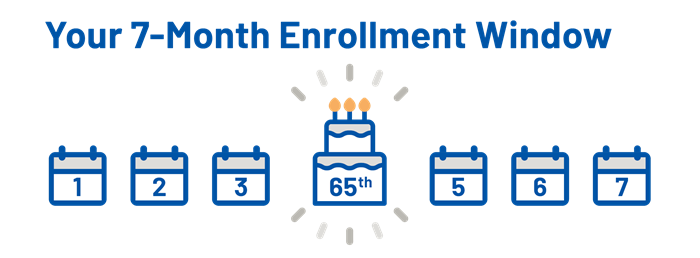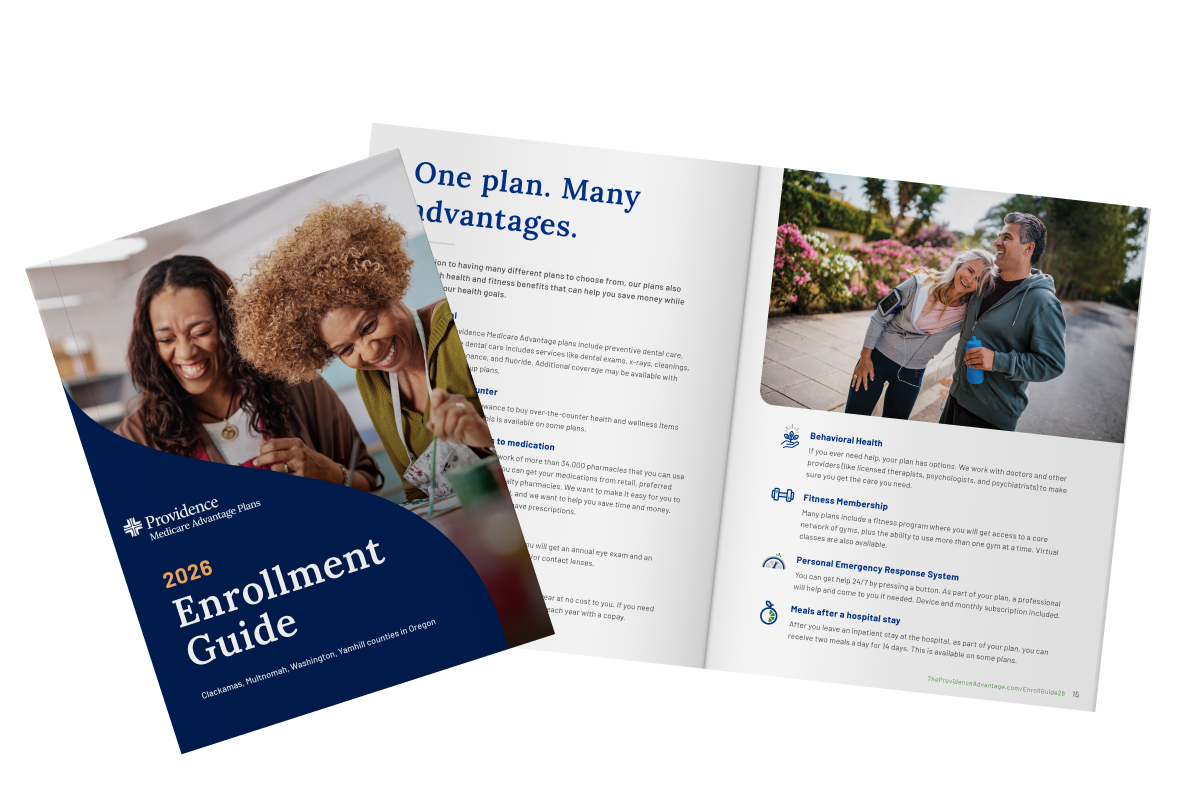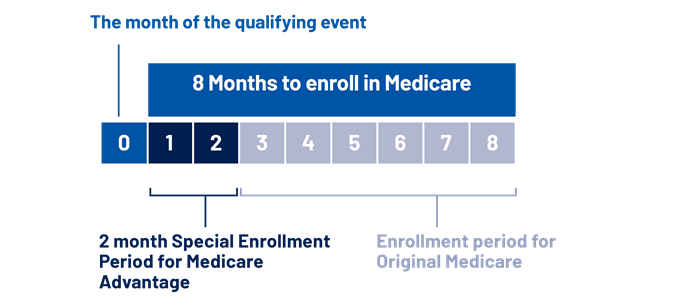Understand your options so you can make the right choice
We're here to help you on your journey. Use this page as your guide or give us a call from 8 a.m. to 5 p.m. (Pacific Time), Monday - Friday
503-574-8416 (TTY: 711)
I'm not yet eligible for Medicare
I am eligible for Medicare
I'm planning on working past 65

Get your Simplifying Medicare Guide
Download the Simplifying Medicare Guide to learn about the basics of Medicare, your enrollment options, and what to do next. For example, Original Medicare, made up of Part A and Part B, provides basic health insurance for hospital and medical needs, but doesn't cover all costs. This guide will provide further details.
Medicare 101 Meetings
At these meetings you'll be able to ask your questions and learn the basics of Medicare, including:
- The different parts of Medicare (the A, B, C, & D's of Medicare)
- The differences between Original Medicare, Medicare Advantage, and Medicare Supplement
- When you should enroll for Original Medicare, Medicare Advantage, and Medicare Supplement
When to enroll in Medicare
Your initial enrollment period
For most people, your initial enrollment window opens when you turn 65. You’ll have a seven-month window to enroll in Medicare: the month you become eligible, the three months prior, and the three months after. Coverage can begin as soon as the first day of the month you turn 65.

You could face penalties for not enrolling in Medicare Part B and Part D when you first become eligible. There are also time periods and life circumstances when you can add additional coverage or make changes.
Annual Enrollment Period (AEP) - October 15th through December 7th
During the Medicare Annual Enrollment Period, you can join, switch, or drop a Medicare Advantage or Part D prescription drug plan, or apply for a Medicare Supplement insurance plan. AEP is not a guaranteed enrollment period for a Medicare Supplement plan. Medical underwriting may be required.
Open Enrollment Period (OEP) - January 1st through March 31st
This period applies only if you’re enrolled in a Medicare Advantage plan. You can switch from one Advantage plan to another (with or without drug coverage). You can also drop your Advantage plan and stick with Original Medicare (with or without a Part D plan).
Special Enrollment Period (SEP)
Medicare also provides a Special Enrollment Period for qualifying life events. Specific dates vary by the qualifying life event, but generally you have two full months after the month of a qualifying event to make plan changes. During this time, you may join, change, or drop a Medicare Advantage or Part D prescription drug plan outside of the Medicare Annual Enrollment period without penalty. Common events that may qualify include:
- Leaving or losing group coverage (example: active, retiree, or union coverage)
- Moving to a new area
- Qualifying for Extra Help with Part A, Part B, or Part D drug costs

Enroll in the right plan with our guide.
Enrolling in Medicare can be complex. This guide will explain what your options are and help you take the next step with confidence. Just enter your information to download.
Attend a meeting to learn about Providence Medicare Advantage plans
Attend a meeting to learn the benefits, costs, and perks for the plans in your area, and get help selecting the best plan for you.
View meeting timesWe've got you covered
Providence Medicare Advantage plans offer you more than Original Medicare.
-
What if my employer has fewer than 20 employees?
If your employer has 20 or more employees, they are required to provide credible coverage.
If they have less than 20 employees, talk with your employer’s benefits administrator to see if they have provide credible coverage. If not, you may need to sign up for Medicare Parts A and B when you turn 65. Medicare would become your primary coverage and your employer coverage would pay secondary to Medicare. Talk with your employer’s benefits administrator or contact us to discuss your specific situation.
-
What is a creditable prescription drug program?
Your employer drug coverage must be at least as good as what Part D coverage provides. If your employer’s drug coverage isn’t creditable, you’ll need to enroll in Part D during your Initial Enrollment Period to avoid the Part D late enrollment penalty. You’ll also need to get either Part A or Part B in order to get Part D.
-
How do I find out if my prescription drug program is creditable?
To keep your employer’s coverage without penalty, you must have creditable Rx coverage. Ask your employer’s benefits administrator if your drug coverage meets CMS’s standards.
-
When does my enrollment period begin?
If you are older than 65 and three months, you'll have a Special Enrollment Period when your group coverage ends. After the month you experience a qualifying event, like retirement or a change to your group benefits, you have 2 months to enroll in Providence Medicare Advantage. Even though you have 8 months to sign up for Original Medicare, to get Medicare Advantage you’ll need to be sure to enroll within those first 2 months.

-
Can I keep using my HSA?
If you plan to work past 65 and delay enrolling in Medicare, stop making HSA contributions at least six months prior to your Medicare effective date to avoid a penalty. Once you’re enrolled in any part of Medicare, you can no longer contribute to your HSA. However, you can use your HSA to cover qualified medical expenses including various Medicare premiums, deductibles and copays.
Frequently Asked Questions
Medicare can be confusing. We’re here to answer your questions and help you make an informed decision. If you don’t find the answers you‘re looking for, attend one of our Medicare 101 educational meetings or webinars.
-
What is Medicare?
Medicare is an insurance program offered through the federal government that covers medical services and hospital care for people 65 or older, younger people with certain disabilities, and people with End Stage Renal Disease (ESRD). Medicare is made up of Part A, Part B, Part C, and Part D. Sometimes referred to as Original Medicare, Part A and Part B are provided by the federal government. Part C and Part D are provided by private health insurance companies but still follow federally mandated Medicare guidelines.
Information taken from cms.gov.
-
What is Medicare Part A: Hospital coverage
Also known as hospital insurance, Medicare Part A covers inpatient services including hospital care, skilled nursing facility care, nursing home care, hospice and home health services. Part A is included in the federally provided Original Medicare, but can also be included in Part C Medicare Advantage Plans provided by private insurance companies.
What it costs
To find out what your costs would be for Medicare Part A coverage, please visit the Medicare costs at a glance on the Medicare.gov website.
Information taken from cms.gov.
-
What is Medicare Part B: Outpatient/physical services coverage
Also known as outpatient medical insurance, Part B covers medically necessary and preventive services such as lab tests, surgeries and doctor visits, and supplies such as wheelchairs and walkers (considered medically necessary to treat a disease or condition).
Part B is optional and can be purchased as part of the federally provided Original Medicare but can also be included in Part C Medicare Advantage Plans provided by private insurance companies.
You must have Part B to enroll in a Medicare Advantage Plan.
What it costs
To find out what your costs would be for Medicare Part B coverage, please visit the Medicare costs at a glance on the Medicare.gov website.
Information taken from cms.gov.
-
What is Medicare Part C: Medicare Advantage Plans
Also known as Medicare Advantage Plans, Part C is an alternative to Part A and Part B and is provided by private health insurance companies (like Providence) who are approved by Medicare. Part C covers all the benefits you receive with Part A and Part B and may offer additional benefits such as dental care, gym memberships, vision care, and prescription coverage (Part D). If you join a Medicare Advantage Plan (Part C), you will still have Original Medicare but will get your Part A and Part B coverage from your Medicare Advantage Plans provider except for hospice care, which will still be provided through Part B. You must also continue to pay your Medicare Part B premium.
What it costs
- Monthly premiums, annual deductibles and costs for services (co-pays and co-insurance) vary by health insurance provider and the plan you choose.
- You will also continue to pay your Medicare Part B premium even if you choose Part C through a private health insurance provider.
- For more information, contact a Providence Medicare Advantage Plans representative today.
Information taken from cms.gov.
-
What is Medicare Part D: Prescription drug coverage
Also known as Medicare Prescription Drug insurance, Part D is offered by private health insurance companies such as Providence. If you have Part A and Part B, or if you have a Part C Medicare Advantage Plan, you may choose to purchase a separate Part D prescription plan from a private health insurance provider. Some Medicare Advantage Plans already include Part D prescription coverage. If you have a Medicare Advantage Plan (Part C) that already has Part D coverage, you cannot enroll in a standalone Part D plan as it would automatically disenroll you from your Medicare Advantage Plan (Part C). If you have a Medicare Advantage Plan (Part C) that doesn’t include prescription coverage and you would like to add a Part D prescription plan, it must be provided by the same health insurance company as your Medicare Advantage Plan.
The prescriptions covered by a Part D plan can vary by health insurance provider, so be sure to review the plan’s approved prescription drug list or “formulary”, prior to making a selection. Part D formularies include a list of covered medications and a description of the transition benefit for existing Part D eligible prescriptions.
What it costs
Monthly premium costs and prescription co-pays will vary by health insurance provider and the plan you choose.
Information taken from cms.gov.
-
I'm already on Medicaid (Oregon Health Plan). Is there a plan for me?
If you qualify for both Medicare and Medicaid, a Dual Special Needs Plan (D-SNP) coordinates your Medicare, Medicaid (also known as the Oregon Health Plan), and Part D coverage to give you extra benefits at no cost. Learn more here.
-
I make less then $23,475 per year, can I get help paying for my prescriptions?
If you are unemployed, meet certain income requirements, and have limited financial resources, you may be eligible for the Extra Help program. Extra Help, also known as Low Income Subsidy (LIS), is a special program that lowers prescription drug and Part D costs. Call 503-574-8416 to see if you qualify or visit here to learn more. You can also apply online for Extra Help here.
-
What is Medigap: Medicare supplemental insurance
Also known as Medicare supplemental insurance, Medigap is another option for filling in coverage gaps in Original Medicare (Part A and Part B). Medigap policies are sold by private insurance companies and allow you to choose any Medicare-certified doctor or hospital regardless of network. Medigap plans are only an option if you are enrolled in Original Medicare (Part A and Part B) and not a Medicare Advantage plan.
For information about Medigap plans, visit www.Medicare.gov.
Information taken from cms.gov.
-
Who is eligible?
Several factors can contribute to Medicare eligibility. You are eligible to enroll in Medicare if:
- You are turning 65
- You are younger than 65 but qualify for Medicare due to a qualifying disability*
- You have end stage renal disease (ESRD)
- You have ALS (amyotrophic lateral sclerosis, also called Lou Gehrig's disease)
* Must have received Social Security Disability benefits for 24 months. There is a five month waiting period after a beneficiary is determined to be disabled before a beneficiary begins to collect Social Security Disability benefits.
Information taken from cms.gov
-
When can I enroll?
Initial Enrollment
Your initial enrollment period (IEP), also called your initial coverage election period (ICEP), is determined by your birthday. The initial enrollment period lasts seven months: the three months before your birthday, the month of your birthday, and the three months following your birthday.
Special Enrollment Periods
Given certain life circumstances, you may be eligible for a special enrollment period (SEP). Circumstances may include the following:
- If you are moving (even if you stay in your current plan’s selling area, you may be able to switch plans if there are new plan options available in your new location)
- If you have moved out of an institution, such as a long-term care or skilled-nursing facility
- If you are no longer eligible for Medicaid
- If your plan has changed its contract
For the full list of qualifying circumstances, go to www.cms.gov.
Annual Enrollment Period
Also referred to as annual election period (AEP), the annual enrollment period is October 15th through December 7th, and is when you can make plan changes. If you don’t currently have prescription coverage (Part D) you can also add it during this time. If you’re happy with your current coverage, you don‘t need to do anything and will be automatically re-enrolled for the next calendar year. Any changes you make will take effect January 1 of the next calendar year.
Medicare Advantage Open Enrollment Period
The open enrollment period is from January 1st to March 31st. During this time, current members may enroll in another Medicare Advantage plan, or disenroll from their Medicare Advantage plan and return to Original Medicare. Individuals may make only one election during the open enrollment period.
Information taken from www.cms.gov.
-
I am a Veteran, do I need Medicare?
The Department of Veterans Affairs (VA) usually recommends that veterans consider enrolling in Medicare to supplement VA healthcare benefits. Having both gives you more ways to get the care you need.
If you’re a veteran, you can have Medicare, TRICARE, and VA healthcare all at the same time. Medicare and TRICARE work together to help cover care outside VA hospitals and clinics. This can help you save money by paying for things like deductibles and coinsurance, so you have fewer out-of-pocket costs and more choices for your care.
How Medicare Advantage Plans work with VA healthcare
If you have VA healthcare, you might also want to look at Medicare Advantage plans. These plans can fill in some of the gaps where VA care may be limited or not available, including:
- Vision and dental care, including exams, glasses, cleanings, and more
- Hearing exams and hearing aid coverage
- Over-the-counter allowance for health and wellness items
- More provider choices outside the VA system
- Programs for nutrition, mental health, weight management, and preventive care
- Extra benefits like gym memberships and meal delivery after hospital stays
- Emergency coverage when traveling or far from VA care
- Access to telehealth service
How Medicare and TRICARE work together for veterans
Deciding if you need both Medicare Advantage and TRICARE depends on your health needs and what feels right for you. If you have both, Medicare pays first when you get care, and TRICARE can help cover the rest.
- If you enroll in a Medicare Advantage plan, it becomes your main coverage.
- TRICARE acts as a backup and usually pays what Medicare doesn’t, like deductibles and coinsurance (if the service is covered by both).
- Prescription drugs are typically covered by TRICARE, so a Medicare Part D plan is usually not needed.
-
Medicare Glossary
Medicare can be confusing. Here's our Medicare Glossary to help you understand the terms.
-
I’m eligible for Medicare. Do I need to cancel my other insurance policy?
In some cases, your coverage may not coordinate benefits with Medicare Part A, Part B, or Part A and B. If you wish to cancel your other coverage and recurring payments as well as ensure your dependents still have the coverage they need, please refer to the document below.
Transitioning to Medicare Advantage (PDF)
For assistance please contact 888-816-1300 (TTY: 711) Monday through Friday 8 a.m. to 5 p.m. (Pacific Time).
-
What's the difference between an HMO and an HMO-POS?
Let’s compare:
HMO-POS
- Great choice if you love to travel
- Has benefits for both in-network and out-of-network providers
- Benefits are stronger if you stay in-network
- Costs more than HMO plans because of larger network
HMO
- Good option if travel isn’t as important
- Costs less than HMO-POS plans
- Out-of-network providers are not covered
Whatever you choose, just remember that not all HMOs are created equal. Some have narrow networks with specific providers, whereas the Providence network gives you access to thousands of providers nationwide.
Legal
Disclaimers & things to know
*Referral to see a specialist is required in California.
For accommodations of persons with special needs at meetings call
503-574-7756 or 888-804-5148 (TTY: 711).
Providence Health Assurance is an HMO, HMO-POS and HMO SNP with Medicare and Oregon Health Plan contracts. Enrollment in Providence Health Assurance depends on contract renewal.
For a complete list of available plans please contact 1-800-MEDICARE (TTY users should call 1-877-486-2048), 24 hours a day/7 days a week or consult www.medicare.gov.
We're here for you. If you need assistance or have questions please reach out to our customer service team at 503-574-8000 or 1-800-603-2340 TTY: 711
8 a.m. to 8 p.m. (Pacific Time), seven days a week. We have reduced weekend hours from April 1st to September 30th and are open between 8 a.m. and 5 p.m. (Pacific Time).
To file a complaint about our marketing, you may call us at 1-800-603-2340 (TTY: 711) 8 a.m. to 8 p.m. (Pacific Time) 7 days a week, October 1st through March 31st and Monday - Friday, April 1st through September 30th, by calling Medicare at 1-800-MEDICARE, 24/7, or by submitting an online form at www.medicare.gov. If you experienced issues with agents or brokers, please include their name in the complaint if possible.
Webpage is current as of: 10/1/2025




